When moving to one place to another in an EPA, it is important to wear the right type of personnel grounding equipment to prevent electrostatic discharge damage on static sensitive components. In this instance, an ESD floor or floor grounding system combined with ESD foot grounders should be used to maintain an ESD protected environment. As regular floors are insulators, and can therefore not be grounded, static charges remain on its surface. When people walk across the floor, these charges then transfer onto them and stay on their body. If a static sensitive component were to be then handled, the static charge from the person’s body will transfer onto the component, resulting in electrostatic damage.
With ESD floors, however, conductive elements such as carbon veins are added to the floor material during the manufacturing process. The conductive elements in the flooring draw the static downwards to ground, away from the surface of the floor. Any charge generated from actions such as walking across a carpet will dissipate to ground. In order for an ESD flooring system to work, ESD footwear or heel grounders must be worn to create a path-to-ground. Shoes for grounding are one of the most important components of an ESD Protected Area, but what are the main solutions for shoes for grounding and how important are they in providing a static safe environment? In this article, we will cover five different solutions for ESD foot grounding in an EPA as well as the advantages of using each type and how to use them.
In the manufacturing industry there are areas within the space that need to be protected from potential ESD occurrences. Electrostatic Discharge, or ESD, is the release of a small electrical charge that would damage a static-sensitive component. So when you are working with ESD sensitive materials and components it is critical that you are aware of the protection you need while working.
An area that is particularly careful about ESD has the correct flooring, equipment and grounding accompaniments installed. This is all alongside the employees being trained in ESD, and the clothing and shoes they wear. When all the regulations are followed and the IEC-61340-5-1 International Standard is met, then the area that needs to be ESD protected becomes an EPA (ESD Protected Area).
Essentially, YES! ESD grounding is essential and when using footwear or heel straps, the best practice is to use them in conjunction with suitable static-dissipative or conductive flooring. As part of the greater picture of ESD control in certain areas, such as storerooms or around equipment, grounding through shoes is important to keep to regulations.
Without correct footwear you risk the damage that electrostatic charge could do to your electronic components. Without the correct grounding through ESD shoes upon an ESD mat or floor you risk breaking the regulations of the IEC-61340-5-1 Standard.
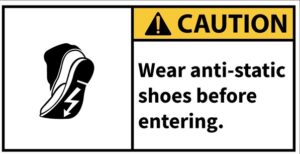
Thankfully, there are several options for all budgets and requirements for ESD foot grounding. Each employee that enters an EPA is required to cover both feet with any of the options below to ensure the company keeps up with the regulations set out to follow the international standards of IEC-61340-1-5 ESD.
Factors to consider are your budget, your industry, and the frequency of employees entering the workplace (or how durable you need the ESD equipment). To help you decide which option is the best fit (no pun intended) for your employees and business you are more than welcome to contact us for an ESD Audit.
ESD shoes are a popular choice for foot grounding in an EPA. They come in a wide range of styles for both men and women, ranging from office styled shoes to heavy duty safety shoes. ESD shoes can either be conductive or dissipative and are designed with comfort and optimal static protection in mind. They are commonly used in electronics manufacturing and assembly applications, and selected to help ensure compliance with ANSI/ESD footwear protocols.
ESD shoes provide superior, continuous static protection when full contact is made with the ESD floor. They protect against static even when one foot is lifted off the ground. Compared to ESD heel and toe straps, ESD shoes are much easier to put on, and so are more likely to be used properly. As well as this, compliance is also easier to monitor. ESD shoes should never be used outside an electrostatic protected area. Therefore, personnel are required to change their regular footwear for ESD shoes before entering the EPA, making compliance easier to regulate. The ESD symbol featured on the shoes is visible indicator of compliance. Bondline supply an extensive range of ESD shoes for grounding in an ESD Protected Area.
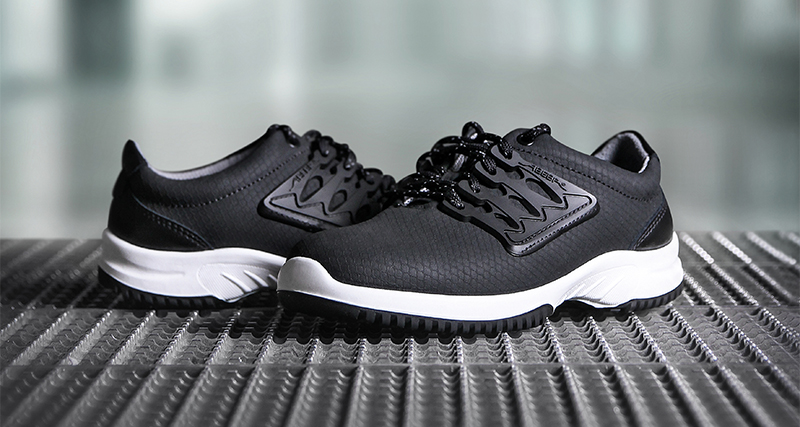
ESD shoes prevent static generation when a person walks across an ESD floor. When ESD shoes come into contact with a grounded flooring system or ESD floor, the conductive elements in the ESD shoes form an electrical bond between the wearer’s body and the carbon veins in the static-dissipative or conductive floor, discharging static to Earth.
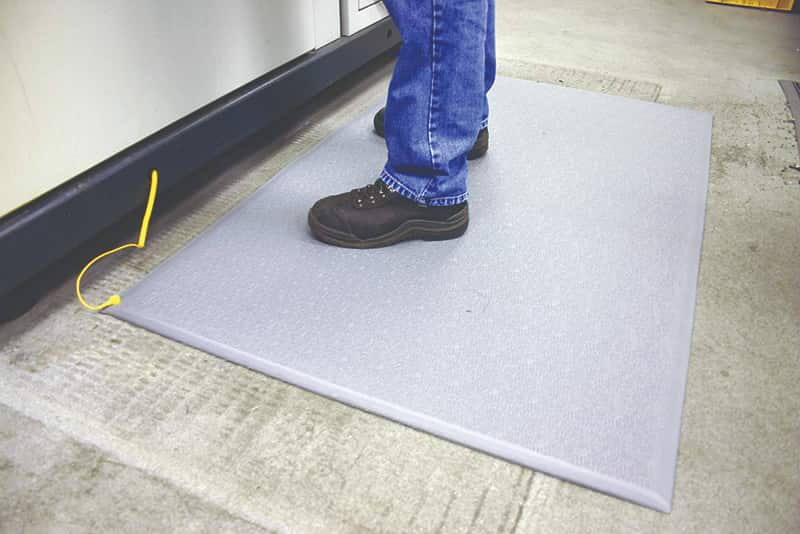
ESD heel grounders are a reliable and inexpensive method for grounding personnel in an EPA. When contact is made with grounded ESD flooring, the heel grounders provide a continuous path-to-Earth by dissipating electrostatic charges from personnel to ground. They are easy to install and can be used with regular shoes by placing the conductive grounding ribbon in the shoe under the foot. An ESD shoe strap is designed to not disrupt the comfort of the wearer’s shoes. There are many different types of ESD heel straps available including quick release heel straps and double rubber heel straps. The type of heel strap you choose is entirely dependent on preference. As well as type, some heel straps may come in either a standard or extra large fit. There are a few options for ESD heel straps from Bondline. Take a look at our range of grounding straps for shoes.
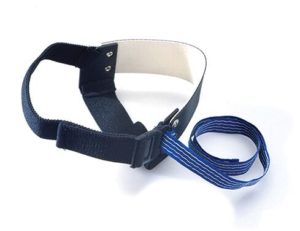
The attached conductive ribbon tucks into the wearer’s sock or shoe, making direct electrical contact with the skin through perspiration. The other end of the resistor is connected to the conductive sole. The sole of the shoe makes contact with the grounded ESD floor. This forms an electrical bond between the wearer’s body and the carbon veins in the conductive or static-dissipative floor, dissipating any static charges to Earth. Grounded heel straps prevent static charge accumulation when people walk across an ESD floor, improving ESD protection in an EPA.
Heel grounders should be worn on both feet in accordance to the IEC-61340-5-1 International Standard to maintain the integrity of the body-to-ground connection. Wearing a heel strap on each foot ensures the ground connection when one foot is lifted off the ESD floor. The grounding ribbon should be placed inside the shoe and lay under the heel. Once the heel has been repositioned inside the tied shoe, the excess ribbon material should be should be tucked into the side of the shoe. The heel cup should be placed onto the shoe. If the heel strap has a non-marking interior, the cup should be installed so that the lined cup surface makes contact with the shoe. The strap should be pulled through the D-ring and cinched down until it feels comfortable and snug. The heel grounder should then be tested with a footwear tester to confirm proper installation.
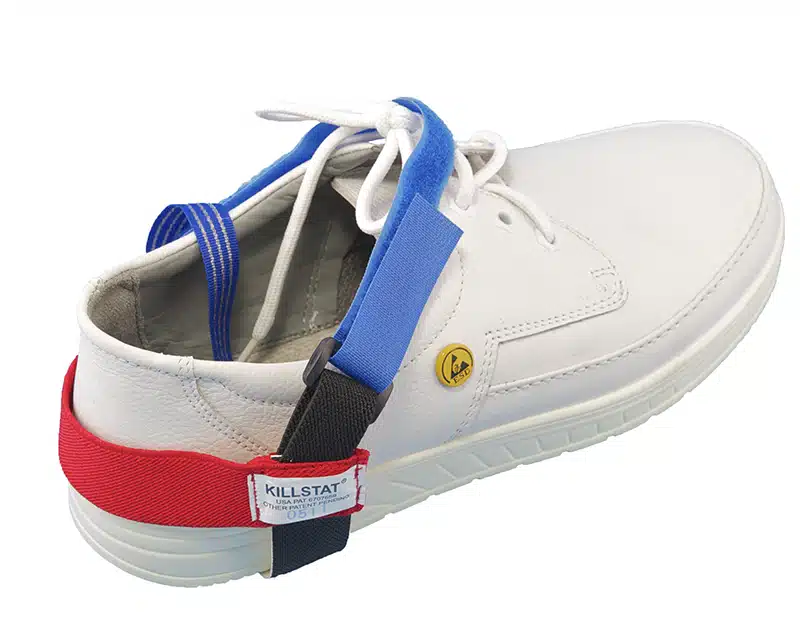
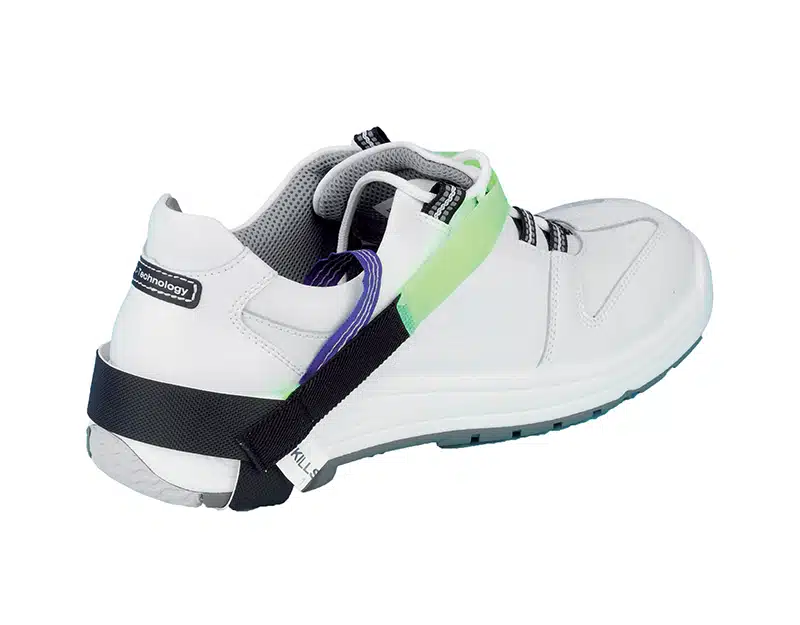
ESD toe grounders, also called conductive toe straps, are suitable to be worn with high-heeled shoes. Toe grounders are designed to cup the toe of the shoe rather than the heel. As with heel straps, ESD toe grounders have an attached conductive grounding ribbon which tucks into the shoe and brings the person, sole of the shoe and floor to the same electrical potential, discharging static to Earth. Conductive toe straps are cost-friendly, re-usable and can be used with standard shoes. They can be used with any shoe size due to the elasticated adjustable straps.
D-ring toe grounders are recommended to be worn on each foot in accordance to the IEC-61340-5-1 International Standard to ensure maximum ESD protection. They are to be used with ESD flooring or ESD floor mats to prove effective. Toe grounders are designed to be used with a variety of men’s and women’s shoes including high heels, flat shoes, loafers and safety shoes. To install a D-ring toe strap, the grounding tab should be inserted inside of the shoe and under the foot. Check to see that there is solid contact between the sock and the body. The grounding tab should be cut to the desired length. The rubber toe material should then be placed under the toe area of the shoe sole. The hook-and-loop strap should be pulled over the top of the shoe and cinched down until it is snug. This should be installed so that the lined surface is making direct contact with the shoe. The elastic strap around the back of the heel should be pulled and the D-ring plastic loop should be adjustable for a comfortable fit. Before using the toe grounders, it is recommended to test each one to confirm proper installation.
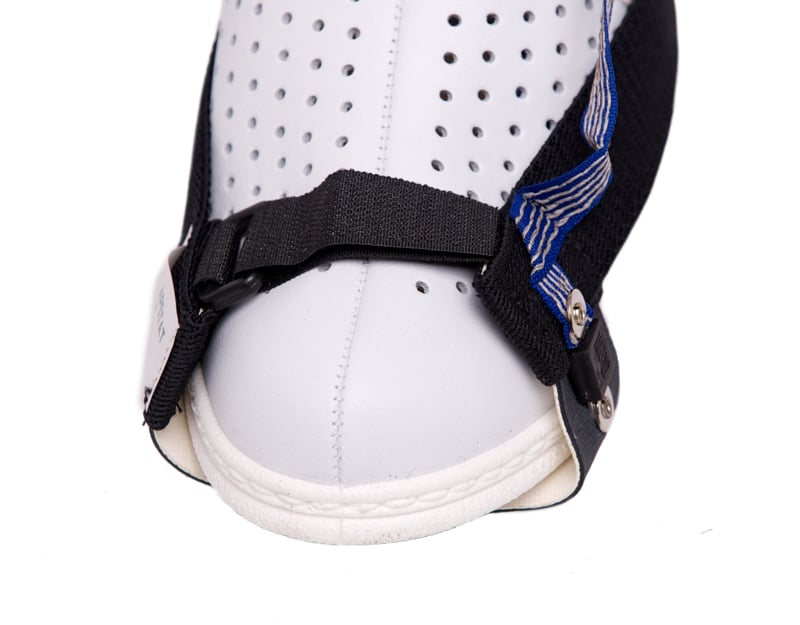
Disposable ESD heel straps are a foot grounding solution that are designed to be worn for short-term use by visitors or personnel. Disposable foot grounders are made so that they may be used once and then disposed of. When it does not make sense to supply a heel strap when a visitor (or similar one off occurrence) needs to enter an EPA a disposable option is the best alternative.
Before applying the conductive strap, existing shoes must be removed and wiped clean of any excess dirt from underside the heel. The release paper from the heel grounder must then be removed. The adhesive end of the foot grounder must be applied to the underside of the heel of the shoe. The tape should be wrapped snugly around the outside of the shoe. The non-adhesive end of the foot grounder should then be applied inside the shoe so that the black dot is over the middle of the heel area facing upwards. Once this has been done, the shoe can be put back on. Before use, the foot straps should be tested to confirm proper installation
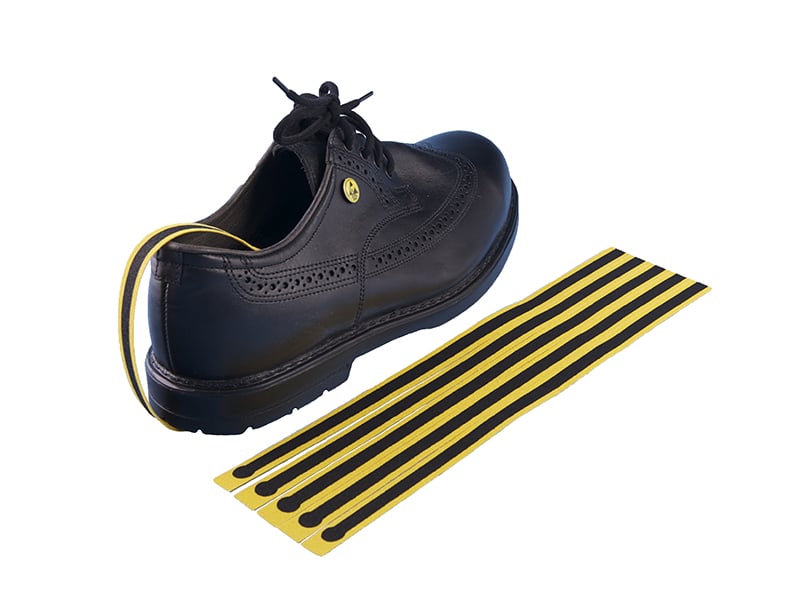
Cleanroom attendees need the option of being ESD protective. Overshoes, also known as cleanroom overshoes, are a great option for personnel who require ESD protective measures when operating in strictly controlled environments. ESD overshoes offer a single-use or reusable solution for controlling contamination and static in controlled environments. While they are commonly used in cleanroom environments, they can also be found in industries such as Electronics Assembly, Medical Device, Aerospace Electronics, Pharmaceutical and Laboratory.
Overshoes are best used for short-term use by personnel or visitors. The ESD shoe cover features non-slip soles for improved safety measures and greater traction. With a one-size fits all, they are designed to fit over most standard footwear.
![Anti-Skid-Polypropylene-ESD-Shoe-Cover-Blue-LG_main-02[2] - Bondline Anti Skid Polypropylene ESD Shoe Cover Blue Bondline](https://www.bondline.co.uk/wp-content/uploads/2019/08/Anti-Skid-Polypropylene-ESD-Shoe-Cover-Blue-LG_main-022.jpg)
Yes! In accordance with the IEC-61340-5-1 International Standard, ESD foot grounding must be worn on both feet. Best practice also dictates that shoe grounding solutions should also be used in an area that has ESD flooring or ESD floor mats to ensure maximum protection. This completes an ESD protected area (EPA).
It is good practice to follow a personnel grounding checklist before entering an EPA to ensure compliance to the IEC-61340-5-1 Standard. Four steps that should be routinely carried out are as follows:
1. Wear antistatic wrist strap and/or ESD foot grounders. Make sure the fit is sufficient and snug.
2. Verify your personnel grounding equipment with an ESD wrist strap/footwear tester to check their functionality
3. Log the test results
4. If your personnel grounding equipment is in compliance, you can now safely handle static sensitive components
If you are ever in doubt, we offer an ESD survey or audit to establish the level of ESD compliance of your company. We can suggest changes to reach international standards, and offer on-site ESD training to ensure regulations are followed. For more information on ESD foot grounding, pleases get in touch with our team on 01793 511000 or email us at sales@bondline.co.uk
Fields marked with an * are required
On selected products if ordered before 1pm
Dedicated account manager to help your ordering process
Great value on premium quality products
Bondline Electronics Ltd are a leading manufacturer and supplier of static control products within the ESD industry. Products such as Flexible and Rigid Packaging, Bench Matting, Wrist Straps, Heel Grounders and Shoes, ESD Protective Clothing and Gloves, Test and Measurement Equipment along with many storage and handling solutions.
Bondline products are all qualified and compliant according to IEC-61340-5-1 International Standard.
Registered Company Number: 02933918
Office Hours: Mon – Thurs: 9am – 5pm Fri: 9am – 2pm

Bondline Electronics Ltd are a leading manufacturer and supplier of static control products within the ESD industry. Products such as Flexible and Rigid Packaging, Bench Matting, Wrist Straps, Heel Grounders and Shoes, ESD Protective Clothing and Gloves, Test and Measurement Equipment along with many storage and handling solutions.
Some of these cookies are essential, while others help us to improve your experience by providing insights into how the site is being used.
For more information and to read more about our privacy policy, please visit our Privacy Policy
Necessary cookies enable core functionality. The website cannot function properly without these cookies, and can only be disabled by changing your browser preferences.